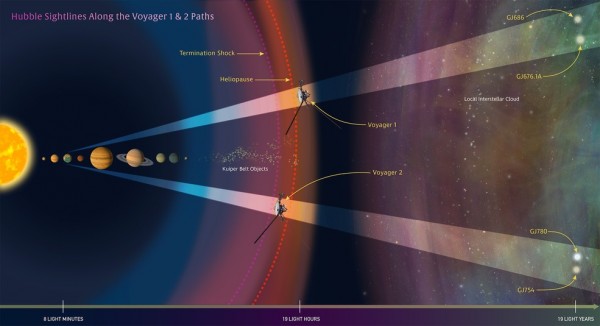By Ana Verayo, | January 09, 2017

NASA's Hubble Space Telescope looks along the paths of NASA's Voyager 1 and 2 spacecraft as they journey through the solar system and into interstellar space. (NASA)
NASA's longest space mission is now entering a new phase, as the Voyager 1 and Voyager 2 space probes exit the solar system into interstellar space, the farthest distance any man-made space probe has ever ventured. The Hubble Space Telescope is monitoring their paths into deep space to learn more about the outer reaches of the solar system and beyond.
Like Us on Facebook
The Voyager 1 was launched in 1977 and completed a successful flyby of Jupiter and Saturn along with their moons. Voyager 2 is the first space probe to visit Uranus and Neptune. However, a decade from now, the spacecrafts will run out of power and stop sending data back to Earth.
According to astronomer Seth Redfield of the Wesleyan University in Connecticut, this is an opportunity to collect and compare data from measurements obtained from the space environment of the Voyager spacecrafts along with telescopic measurements from Hubble.
With the help of Hubble's observations, astronomers were able to gain new insight into the physical properties of the Local Interstellar Medium which is this colossal bubble that encases the entire solar system.
Astronomers say that Voyager 2 is expected to break through this interstellar cloud within 2,000 years which means it will spend 90,000 years traveling within a second interstellar cloud. On the other hand, it is still unknown when Voyager 1 will exit the Local Interstellar Medium.
According to NASA, in the next decade, the Voyager probes will collect data and measurements of this interstellar material, magnetic fields, and cosmic rays and their trajectories. The Hubble Space Telescope will then complement these observations from the Voyager probes by also observing the two sight lines of each probe's path to map out this interstellar structure and their stellar routes.
Each of these sight lines run across several light years to nearby stars. Hubble will obtain sample light from these stars using its Imaging Spectrograph to measure the interstellar material from the Voyager probes. Hubble would absorb this starlight, as spectral fingerprints.
Past Hubble data have analyzed how the sun travels in interstellar space and how the heliosphere, which is also a massive bubble around our solar system produced from solar winds, is interacting with stellar gas and dust in deep space.
-
Use of Coronavirus Pandemic Drones Raises Privacy Concerns: Drones Spread Fear, Local Officials Say

-
Coronavirus Hampers The Delivery Of Lockheed Martin F-35 Stealth Fighters For 2020

-
Instagram Speeds Up Plans to Add Account Memorialization Feature Due to COVID-19 Deaths

-
NASA: Perseverance Plans to Bring 'Mars Rock' to Earth in 2031

-
600 Dead And 3,000 In The Hospital as Iranians Believed Drinking High-Concentrations of Alcohol Can Cure The Coronavirus

-
600 Dead And 3,000 In The Hospital as Iranians Believed Drinking High-Concentrations of Alcohol Can Cure The Coronavirus

-
COVID-19: Doctors, Nurses Use Virtual Reality to Learn New Skills in Treating Coronavirus Patients







